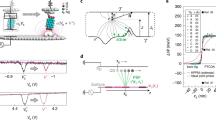Abstract
THE invention of the scanning tunnelling microscope1 (STM) has stimulated the development of several new forms of probe microscopy2–10. Here we demonstrate the use of a microscope that is capable of measuring chemical-potential variations on an atomic scale—the scanning chemical potential microscope (SCPM). The system is based on a recently developed tunnelling thermometer11, which allows the spatial mapping, on an atomic scale, of thermoelectric potential variations resulting from absorption of light, by scanning a conducting tip within tunnelling range of a conducting (or semiconducting) sample. In the SCPM, we replace the optical pump with an electrical sample heater, to generate a temperature gradient between the sample and the tunnel-current-measuring device. We measure the spatial variations in the thermoelectric voltage across the tip–sample system as the tip is scanned across the sample surface with no external bias. This signal can be shown to be equal to the product of the local gradient of chemical potential with respect to temperature and the temperature differential normal to the surface being imaged. The images obtained in this way show features that are not present in the conventional STM images.
This is a preview of subscription content, access via your institution
Access options
Subscribe to this journal
Receive 51 print issues and online access
$199.00 per year
only $3.90 per issue
Buy this article
- Purchase on Springer Link
- Instant access to full article PDF
Prices may be subject to local taxes which are calculated during checkout
Similar content being viewed by others
References
Binnig, G., Rohrer, H., Gerber, Ch. & Weibel, E. Phys. Rev. Lett. 49, 57–61 (1982).
Durig, U., Pohl, D. W. & Rohner, F. J. appl. Phys. 59, 3318–3327 (1986).
Betzig, E., Lewis, A., Harootunian, A., Isaacson, M. & Kratschmer, E. Biophys. J. 49, 269–279 (1986).
Williams, C. C. & Wickramasinghe, H. K. Appl. Phys. Lett. 49, 1587–1589 (1986).
Binnig, G., Quate, C. F. & Gerber, C. Phys. Rev. Lett. 56, 930–933 (1986).
Martin, Y. & Wickramasinghe, H. K. Appl. Phys. Lett. 50, 1455–1457 (1987).
Martin, Y., Abraham, D. W. & Wickramasinghe, H. K. Appl. Phys. Lett. 52, 1103–1105 (1988).
Mate, C. M., McClelland, G. M., Erlandson, R. & Chiang, S. Phys. Rev. Lett. 59, 1942–1945 (1987).
Manassen, Y., Hamers, R. J., Demuth, J. E. & Castellano, A. E. Jr. Phys. Rev. Lett. 62, 2531–2534 (1989).
Hansma, P. K., Drake, B., Marti, O., Gould, S. A. C. & Prater, C. B. Science 243, 641–643 (1989).
Weaver, J. M. R., Walpita, L. M. & Wickramasinghe, H. K. Nature 342, 783–785 (1989).
Stupian, G. W. & Leung, M. S. Appl. Phys. Lett. 51, 1560–1562 (1987).
Sarid, D. & Henson, D. Appl. Phys. Lett. 52, 2252–2254 (1988).
Author information
Authors and Affiliations
Rights and permissions
About this article
Cite this article
Williams, C., Wickramasinghe, H. Microscopy of chemical-potential variations on an atomic scale. Nature 344, 317–319 (1990). https://doi.org/10.1038/344317a0
Received:
Accepted:
Issue Date:
DOI: https://doi.org/10.1038/344317a0
Comments
By submitting a comment you agree to abide by our Terms and Community Guidelines. If you find something abusive or that does not comply with our terms or guidelines please flag it as inappropriate.



